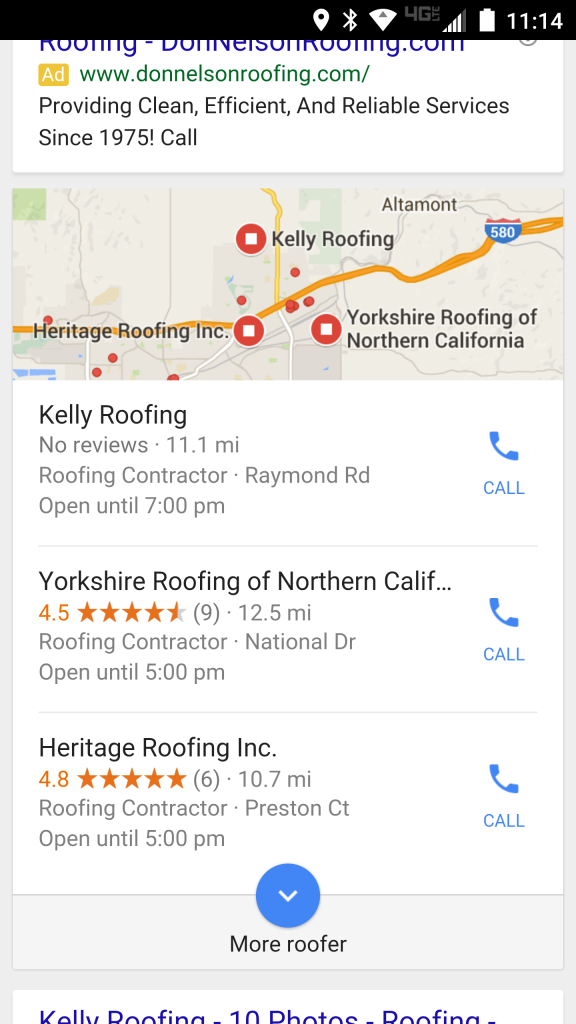Spend five minutes on the internet and there’s a good chance you’ll run into Google’s new local search result module, which Mike Blumenthal dubbed the “Local Stack”.

Google Local Stack showing results for “roofer in Livermore”
If you have any issues with the new stack, you’re in good company. Critics have complained that the stack makes it harder for up and coming businesses to compete, suffers from a bunch of UX flaws, and looks suspiciously like Google’s new Home Service Ads.
But that’s just the tip of the iceberg. Here are just a few more headaches that might not be obvious. You might want to keep a stress ball handy.
1. The Local Stack Hides Phone Numbers
Contractors know that phone numbers can play a big role in your branding. A good vanity number can help keep top of mind awareness (like 925-555-ROOF for a roofer) while an old prefix can show you’ve been local for decades (good luck getting a new 373-xxxx line in Livermore.) Other distinct numbers, or numbers that are posted on enough offline materials, can also contribute to your branding.
If you’re in love with your phone number, that’s too bad, because Google doesn’t care. While the desktop local stack at least lets users click through to see phone numbers, the mobile stack just displays a “call” button.

A search for “roofer in Livermore” on a mobile device
2. The Local Stack Hides URLs
Dr. Adam Paiso’s business, the “Livermore Chiropractic and Wellness Center”, is easy to confuse with his competitor, “Livermore Chiropractic”. His domain name, drpaiso.com, helped clear up that confusion. That is, until Google chose to hide it in the local stack.
Display URLs contain a ton of information for users. They’re important for brand exposure, building trust, and setting landing page expectations. It’s easy to find resources on the importance of display URLs for ad campaigns, and if you’ve been following our blog you may have seen ebola.com sell for big bucks. If you run your own business, you’ve probably been tempted to buy a “better” domain at one point or another.
Again, Google has chosen to take the URLs out of the equation for the local stack, so we can rely more on their shadowy ranking algorithm and easily spoofed reviews, instead of our own intuition. Thanks for that.
3. It’s Basically Impossible To Leave Reviews for a New Business
As Jennifer Slegg pointed out on Moz.com, it just became a lot harder for a business to earn their first Google review the old fashioned way. If you don’t have at least one review on Google, the option for a user to leave one disappears. Literally.
The workaround solution involves hunting down a business’s Google+ page, which used to be linked to their Google map pack listings… until the local stack replaced them. Nowadays, the chance of earning your first Google review organically, without outreach, is basically 0%. Since reviews factor into about 10% of your overall local rank, at a conservative estimate, you now get to drop everything and buy into a review acquisition platform. That means Irish Heating & Air‘s owner now gets to spend more time with GetFiveStars or Nearby Now on his iPhone and less time installing HVACs.
(note: no offense to GetFiveStars or Nearby Now. We’ve looked at a lot of review acquisition platforms and those two will give you the best bang for your buck, by far.)
4. Is Your Address Hidden? Not Anymore!
On the old Google map pack, it was possible to list your business as a strictly service area business, without a brick and mortar presence. For smaller contractors who work out of their homes and trucks, that worked great.
You can probably guess where this is going. As Phil Rozek pointed out, the new local stack will put a pin on your address, whether your address is supposed to be displayed or not. So make sure you clean the guest bathroom, because you might have some company.
Why Did Google Switch to the Local Stack?
The short answer is that Google wanted a more consistent local search module. Instead of seeing 3, 5, and 7 packs (listing businesses A through C, E, or G), carousels, a different style of listing on Google Maps, and a completely different layout on mobile, we now pretty much get the same kind of listings everywhere. That means users should know where to find what they’re looking for a little quicker — even if it takes a couple extra clicks to get there.
Of course, it’s worth mentioning that the layout also looks a lot like their new Home Service Ads, which are still in beta testing for now. Considering how aggressively they rolled out the local stack, and how rough it is around the edges, you better believe that Google has something up their sleeves.





